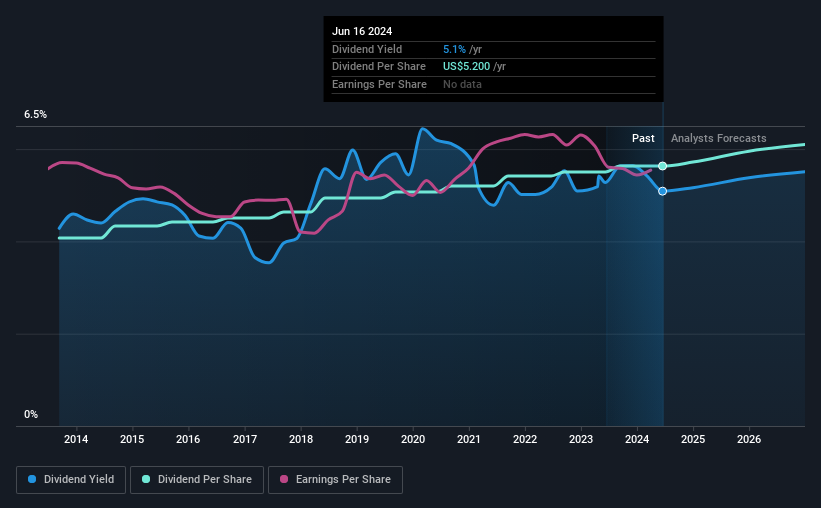- United States
- /
- Tobacco
- /
- NYSE:PM
Don't Buy Philip Morris International Inc. (NYSE:PM) For Its Next Dividend Without Doing These Checks

It looks like Philip Morris International Inc. (NYSE:PM) is about to go ex-dividend in the next 4 days. The ex-dividend date occurs one day before the record date which is the day on which shareholders need to be on the company's books in order to receive a dividend. The ex-dividend date is important because any transaction on a stock needs to have been settled before the record date in order to be eligible for a dividend. Thus, you can purchase Philip Morris International's shares before the 21st of June in order to receive the dividend, which the company will pay on the 8th of July.
The company's upcoming dividend is US$1.30 a share, following on from the last 12 months, when the company distributed a total of US$5.20 per share to shareholders. Based on the last year's worth of payments, Philip Morris International stock has a trailing yield of around 5.1% on the current share price of US$102.20. Dividends are a major contributor to investment returns for long term holders, but only if the dividend continues to be paid. So we need to check whether the dividend payments are covered, and if earnings are growing.
Check out our latest analysis for Philip Morris International
If a company pays out more in dividends than it earned, then the dividend might become unsustainable - hardly an ideal situation. Philip Morris International paid out 101% of its earnings, which is more than we're comfortable with, unless there are mitigating circumstances. That said, even highly profitable companies sometimes might not generate enough cash to pay the dividend, which is why we should always check if the dividend is covered by cash flow. Over the last year, it paid out more than three-quarters (90%) of its free cash flow generated, which is fairly high and may be starting to limit reinvestment in the business.
It's disappointing to see that the dividend was not covered by profits, but cash is more important from a dividend sustainability perspective, and Philip Morris International fortunately did generate enough cash to fund its dividend. If executives were to continue paying more in dividends than the company reported in profits, we'd view this as a warning sign. Extraordinarily few companies are capable of persistently paying a dividend that is greater than their profits.
Click here to see the company's payout ratio, plus analyst estimates of its future dividends.

Have Earnings And Dividends Been Growing?
Stocks with flat earnings can still be attractive dividend payers, but it is important to be more conservative with your approach and demand a greater margin for safety when it comes to dividend sustainability. If earnings fall far enough, the company could be forced to cut its dividend. That explains why we're not overly excited about Philip Morris International's flat earnings over the past five years. We'd take that over an earnings decline any day, but in the long run, the best dividend stocks all grow their earnings per share.
Many investors will assess a company's dividend performance by evaluating how much the dividend payments have changed over time. In the past 10 years, Philip Morris International has increased its dividend at approximately 3.3% a year on average.
The Bottom Line
Has Philip Morris International got what it takes to maintain its dividend payments? Flat earnings per share and a high payout ratio are not what we like to see, although at least it paid out a lower percentage of its free cash flow. Overall it doesn't look like the most suitable dividend stock for a long-term buy and hold investor.
With that being said, if you're still considering Philip Morris International as an investment, you'll find it beneficial to know what risks this stock is facing. We've identified 3 warning signs with Philip Morris International (at least 1 which shouldn't be ignored), and understanding them should be part of your investment process.
Generally, we wouldn't recommend just buying the first dividend stock you see. Here's a curated list of interesting stocks that are strong dividend payers.
New: Manage All Your Stock Portfolios in One Place
We've created the ultimate portfolio companion for stock investors, and it's free.
• Connect an unlimited number of Portfolios and see your total in one currency
• Be alerted to new Warning Signs or Risks via email or mobile
• Track the Fair Value of your stocks
Have feedback on this article? Concerned about the content? Get in touch with us directly. Alternatively, email editorial-team (at) simplywallst.com.
This article by Simply Wall St is general in nature. We provide commentary based on historical data and analyst forecasts only using an unbiased methodology and our articles are not intended to be financial advice. It does not constitute a recommendation to buy or sell any stock, and does not take account of your objectives, or your financial situation. We aim to bring you long-term focused analysis driven by fundamental data. Note that our analysis may not factor in the latest price-sensitive company announcements or qualitative material. Simply Wall St has no position in any stocks mentioned.
Have feedback on this article? Concerned about the content? Get in touch with us directly. Alternatively, email editorial-team@simplywallst.com
About NYSE:PM
Philip Morris International
Operates as a tobacco company working to delivers a smoke-free future and evolving portfolio for the long-term to include products outside of the tobacco and nicotine sector.
Solid track record established dividend payer.

